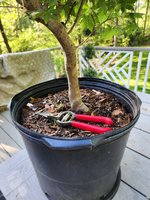Danonito
Yamadori
Hello all,
I'm new member but long time lurker in the forum. Cutting straight to the chase. The attached photo is a Japanese Maple growing in the front of my house since around 07-08 (I moved into the house last year). The previous owners most likely let her grow unchecked apart for a few major cuts at the top of the canopy. I dont want to dig the tree out (yet) due to the bad inverse taper but I do want to make several air layers at the green marked spots. The aim is to lighten the tree, make it look less like a bush and more like a niwaki and also have a few thick layers for future bonsai projects. The two bottom layers close to the trunk actually belong to a big branch behind the main trunk but the photo gives a different illusion. Future leader will be one of the two blue lines.
Do you have any suggestions or tips for this plan? Too many air layers maybe? Any other proposals on where to cut/airlayer to produce a nice future result? The tree is very healthy facing south, zone 8b. (NL)
Thank you all in advance.
I'm new member but long time lurker in the forum. Cutting straight to the chase. The attached photo is a Japanese Maple growing in the front of my house since around 07-08 (I moved into the house last year). The previous owners most likely let her grow unchecked apart for a few major cuts at the top of the canopy. I dont want to dig the tree out (yet) due to the bad inverse taper but I do want to make several air layers at the green marked spots. The aim is to lighten the tree, make it look less like a bush and more like a niwaki and also have a few thick layers for future bonsai projects. The two bottom layers close to the trunk actually belong to a big branch behind the main trunk but the photo gives a different illusion. Future leader will be one of the two blue lines.
Do you have any suggestions or tips for this plan? Too many air layers maybe? Any other proposals on where to cut/airlayer to produce a nice future result? The tree is very healthy facing south, zone 8b. (NL)
Thank you all in advance.











